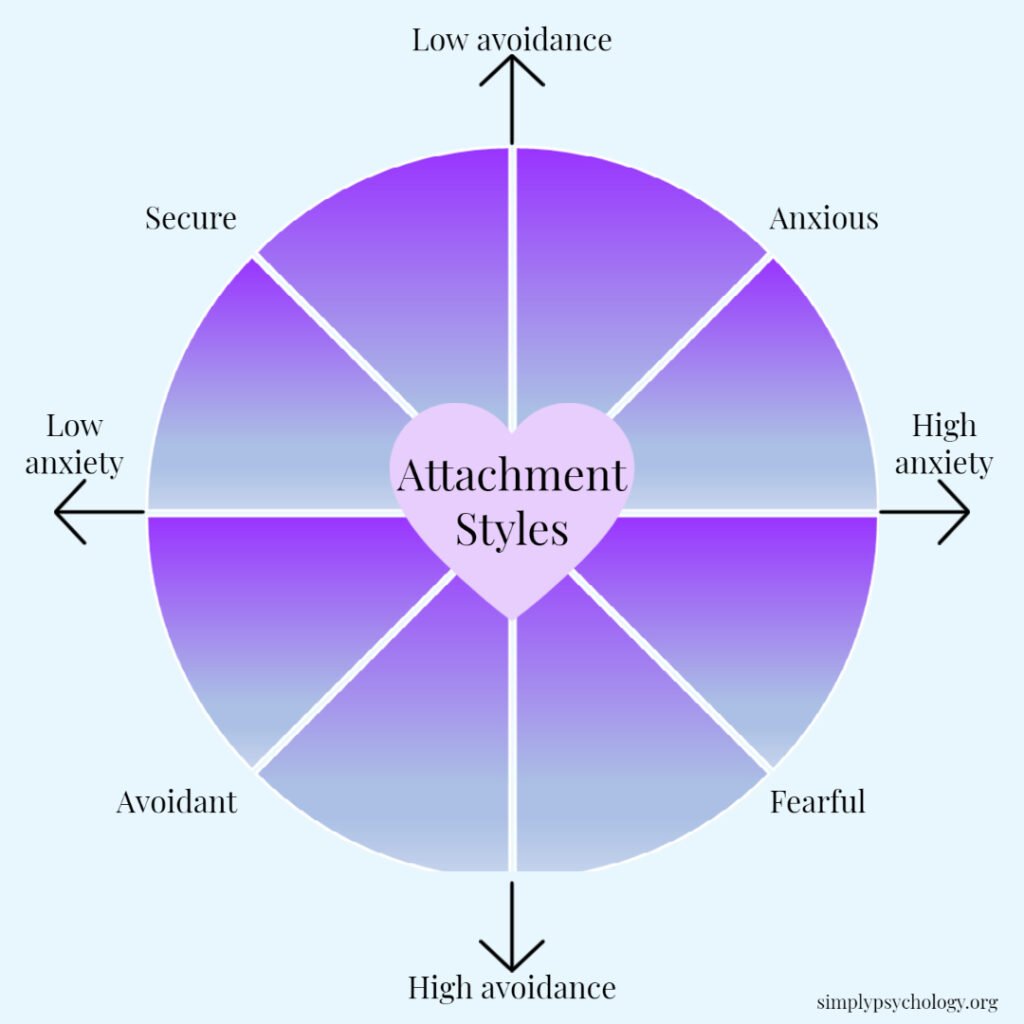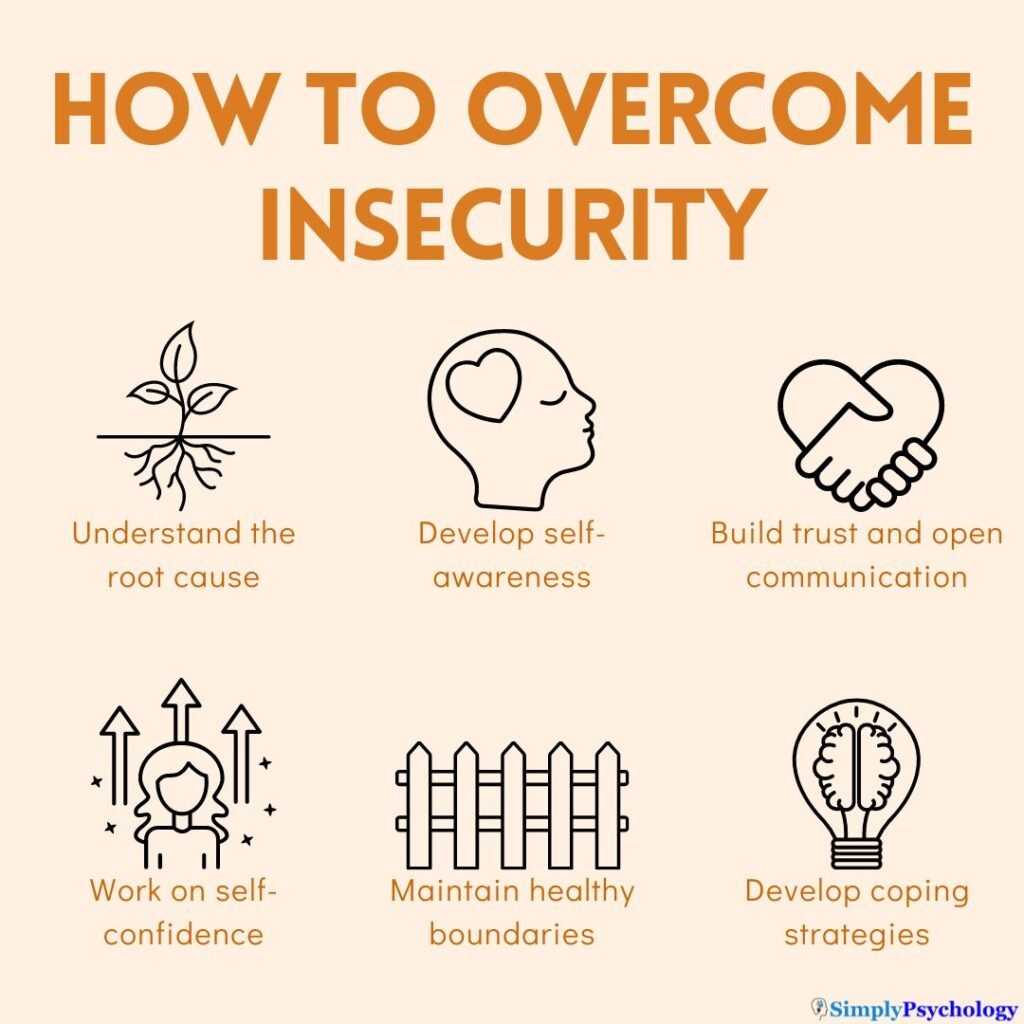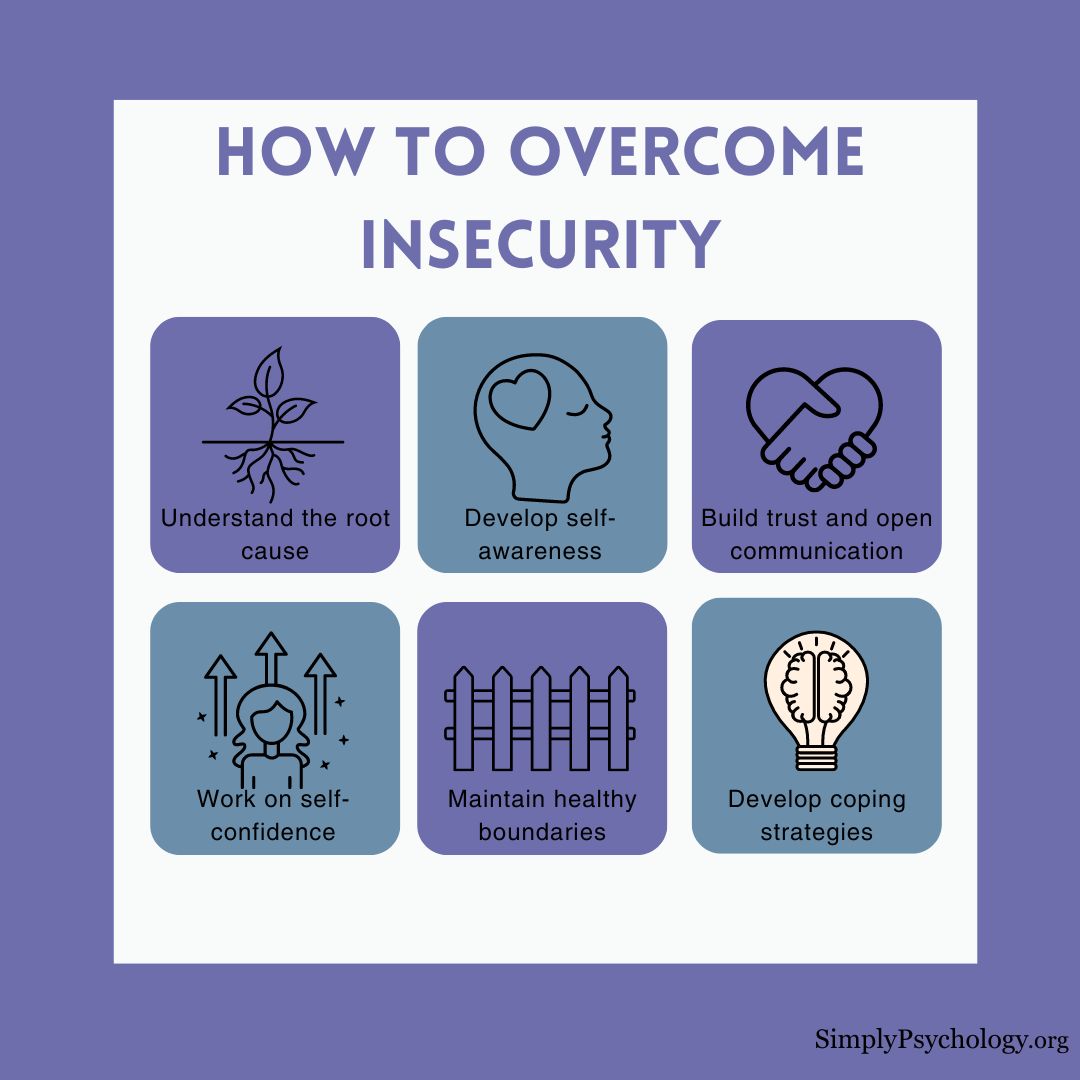Insecurity is characterized by mistrust, anxiety, and a pervasive sense of inadequacy. Insecurity often manifests as a complex mix of emotions, thoughts, and behaviors that can have a significant impact on an individual’s mental health and relationships.
Insecurity in relationships can stem from various factors, both internal and external. Insecurities refer to the deep-seated fears, doubts, and uncertainties that can profoundly impact an individual’s self-confidence and emotional stability within the context of a romantic relationship.
These negative feelings can undermine open communication, breed jealousy, and hinder the growth and harmony of the partnership.
There are many potential causes of insecurity in relationships, including low self-esteem, past traumas, attachment style, lack of communication, or lack of trust.

A combination of internal and external factors can cause insecurity in a relationship. Below are some common causes of insecurity in relationships:
1. Past Relationships or Traumas
Previous experiences, especially negative ones, may carry unresolved emotional issues into new relationships. Betrayal, infidelity, emotional manipulation, or abuse can leave emotional scars that make it difficult to trust and feel secure in future relationships.
Carrying such unresolved emotional issues from previous relationships into a new one can create challenges in communication, emotional intimacy, and trust.
If a past relationship was filled with tension, mistrust, or hurt, this can shape a person’s perception of themselves and affect their ability to trust their current partner and feel secure in the relationship.
Additionally, trauma bonding can cause individuals to be drawn to unhealthy or abusive partners, perpetuating these negative relationship patterns.
2. Attachment Style
Attachment styles developed during childhood relationships can impact trust, communication, and emotional availability in adult relationships. Attachment theory suggests that our early experiences with caregivers can shape how individuals form attachments in adulthood.
People with insecure attachment styles (e.g., avoidant or anxious) tend to be more prone to insecurity.

Those with an avoidant attachment style tend to struggle with emotional intimacy in relationships. They often have difficulty expressing and sharing their emotions with their partners and may downplay or minimize their feelings, even when they care deeply about someone.
They tend to have a strong fear of becoming too emotionally vulnerable in relationships as they equate emotional intimacy with a loss of independence and a fear getting hurt. As such, they will prioritize self-reliance over emotional connection, which can create emotional distance in relationships.
Conversely, a person with an anxious attachment style will often exhibit behaviors and emotions characterized by a fear of abandonment and a constant need for reassurance in their relationships.
They tend to have an irrational, deep-seated fear of being abandoned or rejected by their partners, which can lead to intense anxiety whenever they perceive a threat to the relationship.
People with an anxious attachment style frequently seek reassurance from their partners to alleviate their fears of abandonment. They may need to hear “I love you” or receive other affirmations regularly to feel secure.
3. Comparisons to Others
Constantly comparing oneself to others, whether in terms of appearance, achievements, or qualities, can lead to feelings of inadequacy and insecurity.
In the context of physical appearance, individuals may constantly compare themselves to others they perceive as more attractive or worry that their partner will find someone else more physically appealing.
People may also compare their accomplishments, career success, or financial status to those of others. This can lead to feelings of inferiority if they perceive their partner as more accomplished or financially stable, which can create competition or resentment within the relationship.
Individuals may compare their own relationship to what they perceive as an “ideal” relationship portrayed in the media, on social media, or among their friends. Or, they may compare their partner’s past romantic relationships to their own. This can lead to unrealistic expectations and dissatisfaction within their own relationship.
4. Lack of Communication
Inadequate communication in a relationship can foster insecurity as it leads to misinterpretations, doubts, and uncertainties. When partners don’t openly discuss their feelings, needs, and concerns, they may go unaddressed. This can leave one or both individuals feeling unfulfilled and neglected.
Lack of communication can also create emotional distance within a relationship. When partners don’t express their thoughts and feelings, it can lead to a sense of disconnection and loneliness.
Unspoken grievances and unresolved issues can fester and lead to growing resentment, and over time, this resentment can erode trust and intimacy.
5. Parental Infidelity
Witnessing parental infidelity can lead to a fundamental erosion of trust, which can have a significant impact on their ability to form healthy relationships in adulthood.
Growing up with infidelity in the family may instill a deep-seated fear of betrayal. These individuals may be constantly on guard in their future relationships, fearing that their partner will cheat or be unfaithful.
People who witness parental infidelity may also have difficulty committing to a relationship in general. They may hesitate to invest emotionally and may keep a distance from their partner to protect themselves from potential heartbreak.
A child may even develop the belief that infidelity is common in relationships. As such, they can be more inclined to betray their spouses or harbor doubts about their faithfulness.
Lastly, forgiving a partner’s mistakes or errors in judgment may be challenging for individuals with a history of witnessing infidelity, as they may be more likely to hold onto grudges and resist working through relationship issues.
6. Low Self-Esteem
Low self-esteem is often a fundamental cause of insecurity in relationships. When individuals don’t have a positive self-image or believe in their self-worth, they may struggle to feel secure in their partner’s love and affection.
They may believe they are not good enough for their partner and harbor feelings of insecurity and inadequacy. They may struggle to believe that they are deserving of a happy, fulfilling relationship.
Low self-esteem often leads people to constantly seek reassurance and validation from their partner to bolster their self-worth.
This can create pressure on the partner to continually provide support, leading to emotional exhaustion and strain in the relationship. They may also become overly dependent on their partner for self-esteem and emotional stability.

7. Fear of Rejection
Individuals with a fear of rejection tend to be hypersensitive to signs that they may be rejected or abandoned in their relationships.
People with a fear of rejection may closely analyze their partner’s words, actions, and behaviors, searching for any hint of potential rejection. They may even misinterpret neutral or positive signals as negative or indicative of impending rejection.
Past experiences of rejection, especially in relationships, can have a profound impact on an individual’s self-esteem and beliefs about their own desirability and worthiness of love. This can create a cycle where they feel inadequate and undeserving of love, leading them to fear that their current partner may also reject them.
A fear of rejection often intersects with a fear of abandonment. Individuals may worry that their partner will leave them for someone else or any perceived reason, regardless of evidence to the contrary.
How to Overcome Insecure Feelings

1. Recognize and Acknowledge Insecurity
The first step is to recognize and acknowledge that you are experiencing insecure feelings, as self-awareness is essential for initiating change.
Here are some steps to gain deeper insight into yourself:
- Pay attention to the thoughts and beliefs that contribute to your insecure feelings.
- Practice mindfulness to observe your thoughts, emotions, and bodily sensations without judgment.
- Seek feedback from supportive friends, family, or professionals who can provide objective insights and reflections on your behavior.
- Journal to explore and gain clarity about your insecurities. Write down your thoughts, experiences, and reflections regularly.
- Engage in personal development activities like therapy or self-help workshops that facilitate reflection and growth.
2. Identity Triggers
Pay attention to the situations, thoughts, or events that trigger your insecurities and try to identify any recurring patterns.
How to better understand the root cause of your insecurity:
- Pay attention to situations, events, or specific triggers that consistently make you feel insecure.
- Think back to your childhood and past experiences. Were there significant events or relationships that contributed to your feelings of insecurity? Consider how these experiences may have shaped your beliefs about yourself.
- Reflect on your family dynamics and the roles you played within your family. Family dynamics and early relationships with parents or caregivers can have a profound impact on your self-esteem and sense of security.
- Consider your attachment style. Attachment theory suggests that early experiences with caregivers can influence how you form attachments in adulthood.
- Question and challenge negative thoughts or beliefs that contribute to insecurity. Reflect on when and why these thoughts started. Replace them with more positive and empowering affirmations.
3. Build Trust and Open Communication
Honest and open communication can reduce insecurity in relationships as both partners can have space to express their thoughts and feelings without judgment.
When you feel insecure, try expressing your concerns to your partner. Discuss the causes of your insecurities and how or when they are triggered. Let your partner know how they can support you and work together on ways to address these issues.
4. Build Self-Esteem
You can help build self-esteem by focusing on your strengths and accomplishments. Treat yourself with the same kindness and understanding that you would offer to a friend. Remember that everyone has insecurities and flaws, and that’s okay.
Celebrate your achievements, no matter how small they may seem.
Prioritizing self-care can also help promote your physical and emotional well-being. Consider engaging in mindfulness practices, such as meditation or deep breathing, exercising regularly, developing a healthy sleep routine, or maintaining a balanced diet.
Identify areas of personal growth and set achievable goals to work on them. This can boost your confidence and sense of self-worth.
5. Maintain Healthy Boundaries
Maintaining healthy boundaries can ensure that your needs and feelings are respected and can help create a sense of safety and security in your relationship.
Boundaries help define what is acceptable and unacceptable behavior in your interactions with others, ensuring that your emotional and physical well-being is respected.
To set boundaries, you first need to understand your own needs, values, and limits. Reflect on what makes you feel comfortable and secure in a relationship.
Communicate your boundaries clearly and assertively. Use “I” statements to express your needs and feelings. For example, say, “I need some alone time to recharge” rather than making accusations or demands.
Pay attention to your feelings. If something makes you uncomfortable or insecure, it may be a sign that a boundary has been crossed or needs to be established.
Be prepared to assertively enforce your boundaries if they are violated. This may involve calmly but firmly communicating that a boundary has been crossed and explaining the consequences.
6. Develop Coping Strategies
Developing coping strategies to overcome insecure feelings can be instrumental in managing and ultimately reducing those feelings.
Some coping strategies include:
- Challenging and reframing negative thoughts related to insecurity.
- Cultivating self-compassion by treating yourself with kindness and understanding.
- Engaging in mindfulness and meditation practices to stay present and reduce rumination about past insecurities or worries about the future.
- Using positive affirmations to counteract negative self-talk.
- Reaching out to friends, family, or a support network when you’re feeling insecure.
- Concentrating on your strengths and accomplishments rather than fixating on your perceived weaknesses or failures.
Furthermore, research self-help techniques. For example, the IF-THEN method helps you identify negative thoughts and feelings and then take action to improve your mood, such as listening to music, exercising, or spending time with friends (e.g., IF I feel angry, THEN I will take a walk).
Dr. Joy Harden Bradford, a licensed psychologist, suggests creating a ‘coping kit’ for when you feel distressed. This could include your journal, useful quotes, pictures of happy memories, or lists of your favorite shows, books, music playlists, or podcast episodes.
7. Consider professional support
Consider therapy or counseling to work with a trained professional on managing your insecurities. They can help you recognize the source of insecurity, heal from negative experiences, increase self-awareness, and provide tools and strategies tailored to your specific needs.
Seek advice from a mental health professional to help you choose the right type of therapy for you. Some methods may be more suitable than others depending on your specific relationship insecurities, individual preferences, and needs.
Below are effective talking therapies:
- Cognitive Behavioral Therapy (CBT) helps identify and challenge negative thought patterns, beliefs, and behaviors.
- Attachment-Based Therapy specifically targets insecure attachment styles and works to promote secure attachment patterns.
- Emotionally Focused Therapy (EFT) is often used in couples therapy but can also be applied individually. It focuses on helping individuals and couples identify and address underlying emotions and attachment needs.
- Acceptance and Commitment Therapy (ACT) is a mindfulness-based therapeutic approach that helps individuals develop self-compassion and acceptance of their thoughts and emotions.
These therapies can be used individually or in combination, depending on an individual’s specific needs and goals. The choice of therapy often depends on the nature of the insecurity, its underlying causes, and whether it primarily affects the individual or their relationships.
Examples Of Relationship Insecurities
Common relationship insecurities can manifest in various ways and may differ from one person to another. Here are some examples of common relationship insecurities:
- Doubts of your worthiness of love, affection, and attention
- Fear of being abandoned or rejected
- Anxiety about the stability and future of the relationship
- Needing constant reassurance from your partner to quell your doubts and fears
- Overthinking and overanalyzing minor incidents or behaviors
- Difficulty trusting your partner’s intentions and sincerity
- Jealousy and possessiveness
- Comparing yourself to your partner’s past relationships or to other people in your partner’s life.
- Feeling out of place or uncomfortable in social situations with a partner’s friends or family
- Concerns about sexual performance, attractiveness, or compatibility
- Having unfounded suspicions of infidelity or betrayal
- Worries about the future of the relationship, such as concerns about marriage, children, or long-term commitment
- A lack of self-worth or self-esteem
Julia Simkus edited this article.
Frequently asked questions
Do insecurities cause jealousy?
Personal insecurities (e.g., low self-esteem) and insecurities about a relationship can contribute to feelings of jealousy. Insecurities are often caused by a lack of self-confidence or trust in others, which can make people prone to jealousy in relationships.
When people feel insecure about themselves or their relationships, they might become jealous of others who they see as being more attractive or successful. They may feel threatened by others and worry about being replaced by them, which can lead to jealousy and possessiveness.
People with insecurities are more likely to interpret situations in a way that confirms their insecurities.
What can trigger insecure feelings in a new relationship?
Feelings of insecurity in a new relationship might be triggered by fears of rejection, low self-confidence, and previous negative experiences.
Potential triggers for insecure feelings include feeling like your partner is not fully committed, feeling unsure about their feelings for you, feeling like you’re not good enough for them, or worrying that they will eventually replace you with someone else.
When insecurity-triggering thoughts or feelings arise, it is important to communicate openly with your partner to resolve them. If you are unable to communicate effectively with your partner, it can cause misunderstandings and insecurity.
It takes time to build trust and security, so be patient with yourself and your partner.
How can insecurities be made worse?
Insecurities can be made worse by various factors and behaviors.
Here are some common ways in which insecurities can be intensified:
1. Continuously engaging in negative self-talk and self-criticism can amplify insecurities. When individuals constantly tell themselves they are not good enough or don’t measure up, it reinforces their insecurities.
2. Comparing oneself to others, especially on social media where people often present curated and idealized versions of their lives, can worsen insecurities. Constantly feeling like you fall short compared to others can intensify feelings of inadequacy.
3. Experiencing criticism, rejection, or failure in various aspects of life, such as relationships, work, or personal goals, can deepen existing insecurities or trigger new ones.
4. Past traumatic events or negative experiences, especially those related to self-esteem and self-worth, can leave lasting scars and contribute to deep-seated insecurities.
Can insecure feelings be present for no apparent reason?
Sometimes people can experience insecure feelings that have no clear source or cause, leaving them confused about the reason for their emotions.
Insecure feelings often stem from underlying psychological factors, such as attachment styles, hidden internal conflicts, or past experiences. Insecurity may also stem from aspects of an individual’s personality type or brain chemistry.
It is important to explore and address unexplained insecurities with self-reflection and potentially seek professional support to gain insight and develop coping strategies.
Further Information
Attached by Amir Levine and Rachel Heller helps people understand their attachment style and recognize the styles of others to find compatible partners or improve existing relationships. The book provides principles for resolving conflict and communicating effectively with each style.
References
Bartholomew, K., & Horowitz, L. M. (1991). Attachment styles and relationship insecurity. Journal of Personality and Social Psychology, 61(2), 355-371. doi:10.1037/0022-3514.61.2.355
Davila, J., Karney, B. R., & Bradbury, T. N. (1999). Insecure attachment and relationship problems: A meta-analytic review. Psychological Bulletin, 125(2), 195
Edelstein, R. S., & Shaver, P. R. (2006). The effects of insecurity on the perception of partner’s communication. Personality and Social Psychology Bulletin, 32(10), 1442-1455. doi:10.1177/0146167206294619
Levine, A., Heller, R. (2012). Attached: The New Science of Adult Attachment and How It Can Help You Find – And Keep – Love. Tarcherperigee.
Mikulincer, M., & Shaver, P. R. (2003). The role of insecurity in interpersonal relationships. Annual Review of Psychology, 54, 195-239. doi:10.1146/annurev.psych.54.101601.135216
Mikulincer, M., & Shaver, P. R. (2012). The relational dynamics of attachment insecurity. Advances in Experimental Social Psychology, 44, 153-217. doi:10.1016/j.aexsp.2012.06.001
Mikulincer, M., & Shaver, P. R. (2016). The attachment-based emotion regulation system. Psychological Review, 123(6), 1595-1632. doi:10.1037/rev0000053
Mikulincer, M., & Shaver, P. R. (2017). Attachment insecurity and interpersonal functioning. Annual Review of Psychology, 68, 501-531. doi:10.1146/annurev-psych-010416-044120
Mikulincer, M., & Shaver, P. R. (2018). Attachment insecurity and health. Current Directions in Psychological Science, 27(1), 6-11. doi:10.1177/0963721417745570
Mikulincer, M., & Shaver, P. R. (2019). Attachment insecurity and psychopathology. Clinical Psychology Review, 60, 101-117. doi:10.1016/j.cpr.2018.10.003
Mikulincer, M., & Shaver, P. R. (2020). Attachment insecurity and coping with stress. Journal of Personality and Social Psychology, 118(1), 132-154. doi:10.1037/pspi0000164
Mikulincer, M., & Shaver, P. R. (2021). Attachment insecurity and social cognition. Personality and Social Psychology Review, 25(2), 176-200. doi:10.1177/1088868320977645
Overall, N. C., Fletcher, G. J. O., & Simpson, J. A. (2006). The role of insecurity in the development and maintenance of conflict in romantic relationships. Journal of Personality and Social Psychology, 91(4), 706-719. doi:10.1037/0022-3514.91.4.706
Overall, N. C., Fletcher, G. J. O., & Simpson, J. A. (2010). Attachment insecurity and relationship instability: A meta-analytic review. Journal of Personality and Social Psychology, 98(2), 349-366. doi:10.1037/a0018813



